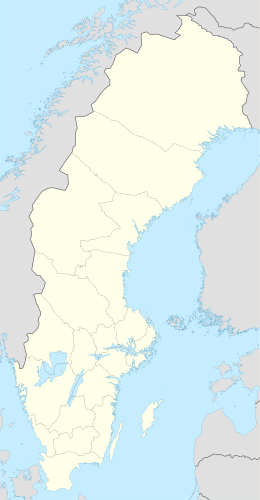Öland
| Nickname: Island of sun and winds | |
|---|---|
| Geography | |
| Location | Baltic Sea |
| Coordinates | 56°44′N 16°40′E / 56.733°N 16.667°ECoordinates: 56°44′N 16°40′E / 56.733°N 16.667°E |
| Area | 1,342 km2 (518 sq mi) |
| Length | 137 km (85.1 mi) |
| Width | 16 km (9.9 mi) |
| Highest elevation | 55 m (180 ft) |
| Highest point | Högsrum |
| Administration | |
| County | Kalmar County |
| Municipality | Borgholm Municipality and Mörbylånga Municipality |
| Largest settlement | Färjestaden (pop. 5 018 inv.) |
| Demographics | |
| Population | 24,640 (2009) |
| Pop. density | 18.63 /km2 (48.25 /sq mi) |
| Ethnic groups | Swedish |
Öland (Swedish pronunciation: [ˈøːland]) is the second largest Swedish island and the smallest of the traditional provinces of Sweden. Öland has an area of 1,342 square kilometres (518 square miles) and is located in the Baltic Sea just off the coast of Småland. The island has 25,000 inhabitants. It is separated from the mainland by the Kalmar Strait and connected to it by the 6-km Öland Bridge, which opened on 30 September 1972.
The traditional provinces of Sweden no longer serve administrative or political purposes but still exist as historical and cultural entities. Öland is part of the administrative county of Kalmar County (Kalmar län) and consists of the two municipalities of Borgholm Municipality and Mörbylånga Municipality. There was an Öland County in the short period between 1819 and 1826; otherwise, the island has been part of Kalmar County since 1634.
Öland was granted provincial arms in 1560, but it would not be until the 1940s that the province was assigned its proper ones. The arms granted to Öland had been mixed up with the arms granted to Åland and this was not discovered until the 20th century. While Öland changed its coat of arms, Åland, which was now a Finnish (autonomous) province, kept its established but originally unintended coat of arms. The deer is meant to symbolise the status of Öland as a royal game park and the arms are topped by a ducal crown. Blazon: "Azure a Deer Or attired, hoofed and gorged Gules."
Archaeological evidence indicates the island of Öland was settled about 8000 BC, with excavations dating from the Paleolithic era showing the presence of hunter-gatherers. In the early Stone Age, settlers from the mainland migrated across the ice bridge that connected the island across the Kalmar Strait.
...
Wikipedia

